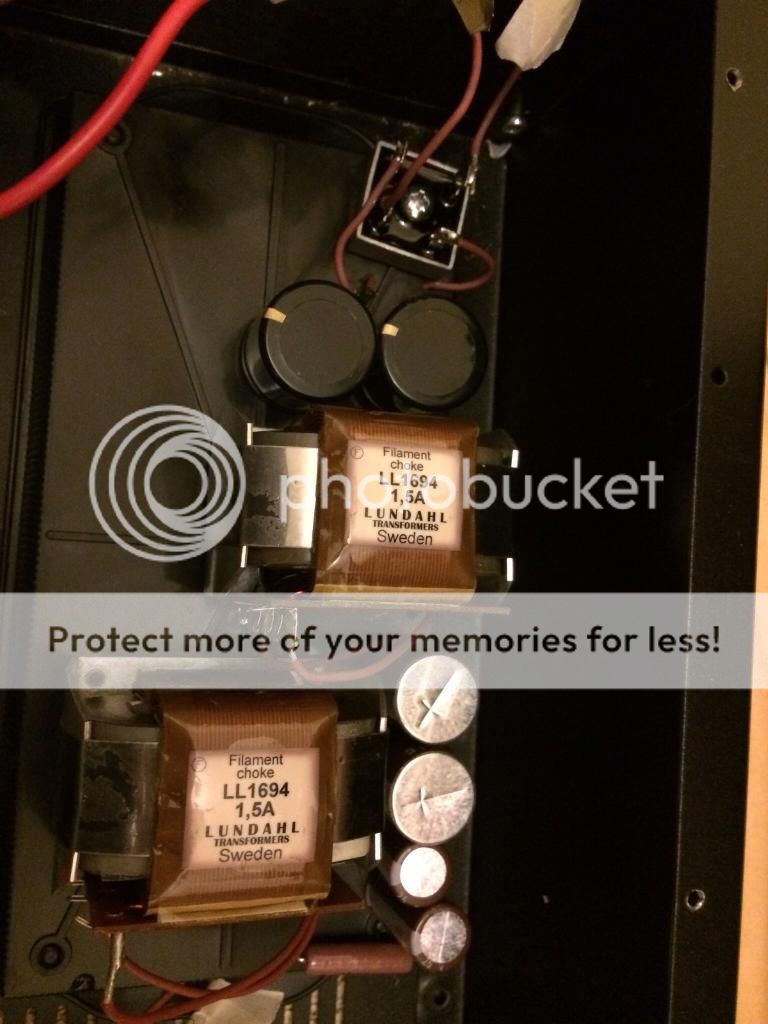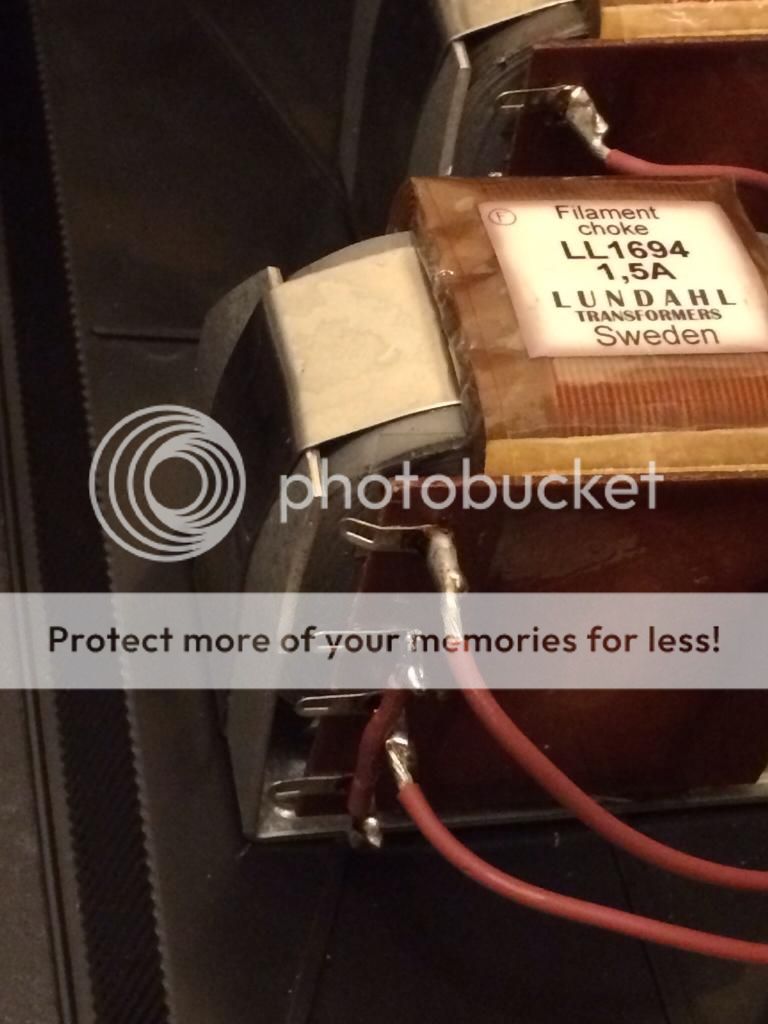yes, it's not designed to work like that, but it seems to work nicely without cables 🙂Dwjames, very nice. The side socket connects straight to another side socket without cables?
Do you have a sketch of the circuit layout?I have wired up the unregulated PSU and the chokes instantly became VERY hot, so there is a problem.
Is it because I was using a 10A rectifier, or could it be because I haven't taken the neutral to earth, or something else?
Thanks
Are you sure that the bridge rectifier is wired the right way around?
What's the resistance and wattage rating of your bleeder resistor? I'd recommend using an alloy bodied 25w or bigger as they can get pretty hot and need heat sinking.
Hi James
The bleed resister is 100R 12W MRA12 Mills Resisto
The circuit is
http://oi58.tinypic.com/apjvw3.jpg
Im pretty sure its all the correct way round, let me go and check once more
The bleed resister is 100R 12W MRA12 Mills Resisto
The circuit is
http://oi58.tinypic.com/apjvw3.jpg
Im pretty sure its all the correct way round, let me go and check once more
Looks good to me. I think a 12w resistor will get too hot, but try it and see.
If you're testing the supply without connecting it to your dddac, you should really add a temporary load of another resistor to simulate the load of your DAC. My single deck with shunts pulls roughly 0.25a, so I use a 47r resistor (voltage/amps=resistance so 12v / 0.25a = 48r)
If you're testing the supply without connecting it to your dddac, you should really add a temporary load of another resistor to simulate the load of your DAC. My single deck with shunts pulls roughly 0.25a, so I use a 47r resistor (voltage/amps=resistance so 12v / 0.25a = 48r)
:s yeah, a 0ohm bleeder's probably a bit excessive.... Was this hotness accompanied by an angry buzzing sound? [emoji14]Hold fire on your problem solving James, I have found a pesky crossed wire.
The chokes were getting REALLY. Hot and starting to crackle. Didn't check the temp of the resister I found a crossed wire between live and neutral, I disconnected it and re wired as it should be, chokes are very cool but I have no reading from the psu . Would it be safe to connect to my DAC to test it further ?
That doesn't sound good at all. With a short, you will have put a massively high amp load through anything before the short and it's quite possible you have damaged the chokes by overheating and melting their wires.... 🙁The chokes were getting REALLY. Hot and starting to crackle. Didn't check the temp of the resister I found a crossed wire between live and neutral, I disconnected it and re wired as it should be, chokes are very cool but I have no reading from the psu . Would it be safe to connect to my DAC to test it further ?
You won't need your DAC connected to work out if the chokes are still ok or not.
With it all turned off, you can try a continuity check between the in and out of each half of each choke, then if that's OK, turn it on and measure dc volts between gnd and the inputs and outputs of the chokes. Hopefully you can get a voltage reading at each point, otherwise you have a break inside a choke..
My chokes don't get hot at all.
Thanks James, the psu was on for about 30 seconds. I'll test it tomorrow as I have a 4am start tomorrow.
Thanks again for your help.
Thanks again for your help.
hello everyone,
I'm trying to have better understanding on the chokes subject. Choke input is the target.
Lundahl says that best mode for psu is common mode for better rejection.
I guess, that since this mode requires a cap before input to the choke, then it should be mounted as a second in line right?
And here comes another question. Lundahl actually refer to single tranny and full bridge rectifire (as I can see on their drawings). In such a configuration that would make sense to me, as the negative comes back to the bridge and is partly reutilised giving the other half wave, and it's ok to smooth it on the way back (this is just my rookie's logic).
But, what if we connected choke to centre tapped tranny, and used two diodes full wave rectifire? Is the common mode still best solution? I saw some posts saying about dirty negative, especially when grounded.
Could anyone shed some light on it, or correct me if I was wrong please?
Thanks in advance 🙂
I'm trying to have better understanding on the chokes subject. Choke input is the target.
Lundahl says that best mode for psu is common mode for better rejection.
I guess, that since this mode requires a cap before input to the choke, then it should be mounted as a second in line right?
And here comes another question. Lundahl actually refer to single tranny and full bridge rectifire (as I can see on their drawings). In such a configuration that would make sense to me, as the negative comes back to the bridge and is partly reutilised giving the other half wave, and it's ok to smooth it on the way back (this is just my rookie's logic).
But, what if we connected choke to centre tapped tranny, and used two diodes full wave rectifire? Is the common mode still best solution? I saw some posts saying about dirty negative, especially when grounded.
Could anyone shed some light on it, or correct me if I was wrong please?
Thanks in advance 🙂
Last edited:
Chanh - The Salas should be a great choice. I use Salas Shunts on all by analog circuits. When I was in college all I could afford was an all-in-one turntable amp setup that cost about as much as 2 Tent Shunts.
Another option for others to consider is a Belleson 5V SPJ78 right at the external terminals. See pictures. I made a small perf board with a 100uf OSCON and .1uf Vishay 1837 film bypass close to the input pin of the Belleson. It is powered by a 7.5-8.0 V filtered, but not regulated, PS powered by a 6.3V 2amp filament transformer. There was a definite upgrade in sq compared to an external regulated linear PS. I use this same unregulated power supply on my 3.3V Bellesons on the digital side of the PCM1794 circuit.
The disc on the XMOS chip is a Black Discus from Mad Scientist Audio in NZ. To me it makes the music sound a bit cleaner. The difference is small, but I don't want to leave it off. Ok, let's hear all the snake oil comments.
Doede, Please consider making a provision for installing an OSCON and film cap next to the input pin of the 3.3V regulator on the Main Board. I've modified both of my Main Boards this way (see pic, film cap under board) and it allows for the Belleson to operate as suggested on their web site. This might be the difference for a premium Vreg on the Main Board making an improvement in sq.
I use this same configuration on my dac and found the same improvement in SQ
..I have no reading from the psu
What do you mean by this? Is you DMM no longer reading any output voltage. In which case something is likely "kaput".
Also i would personally not connect the DDDAC without having dailed in the unregulated supply with a testload. I think I used 16Ohm as a load to test with (maybe 8Ohm, can't remember)
I don't know how big your transformer is but a 30sec overload on the chokes doesn't sound very good.
I would always recommend using a small inline lightbulb as a current limiter when firing a new PSU up for the first time...
Just for reference, I forced my BBB to always boot from the SD card instead of the onboard emmc by plugging it into my laptop via the usb whilst having no SD card installed, which mounted it's emmc as a drive on my computer. I moved the file called MLO out of the root directory into the /app directory. I did this rather than deleting it so I can reinstate it later if needed.I just need to finish up and work out how to install the external power button to the beaglebone and force it to always boot from the sd card.
It seems this is enough to stop the BBB from booting from the emmc each time and instead failover to always boot from the SD card.
Just for reference, I forced my BBB to always boot from the SD card instead of the onboard emmc by plugging it into my laptop via the usb whilst having no SD card installed, which mounted it's emmc as a drive on my computer. I moved the file called MLO out of the root directory into the /app directory. I did this rather than deleting it so I can reinstate it later if needed.
It seems this is enough to stop the BBB from booting from the emmc each time and instead failover to always boot from the SD card.
I wish I knew what you are talking about.........🙂
I wish I knew what you are talking about.........🙂
😛
the beaglebone black (BBB) has onboard memory called the emmc. It contains an operating system, so you can just get it out the box, plug it in and it will boot up nicely into their demo operating system. If you want to run software off the SD card instead, you need to hold down a teeny boot button on the board for 5 seconds at the same time as you power it up. This is all good until you come to put it into a case and don't want to have to touch it.
So all I've done is found a simple non-destructive way to knobble the onboard operating system, so it always boots off the SD card.
😛
the beaglebone black (BBB) has onboard memory called the emmc. It contains an operating system, so you can just get it out the box, plug it in and it will boot up nicely into their demo operating system. If you want to run software off the SD card instead, you need to hold down a teeny boot button on the board for 5 seconds at the same time as you power it up. This is all good until you come to put it into a case and don't want to have to touch it.
So all I've done is found a simple non-destructive way to knobble the onboard operating system, so it always boots off the SD card.
Thanks for the explanation!
- Home
- Source & Line
- Digital Line Level
- A NOS 192/24 DAC with the PCM1794 (and WaveIO USB input)

